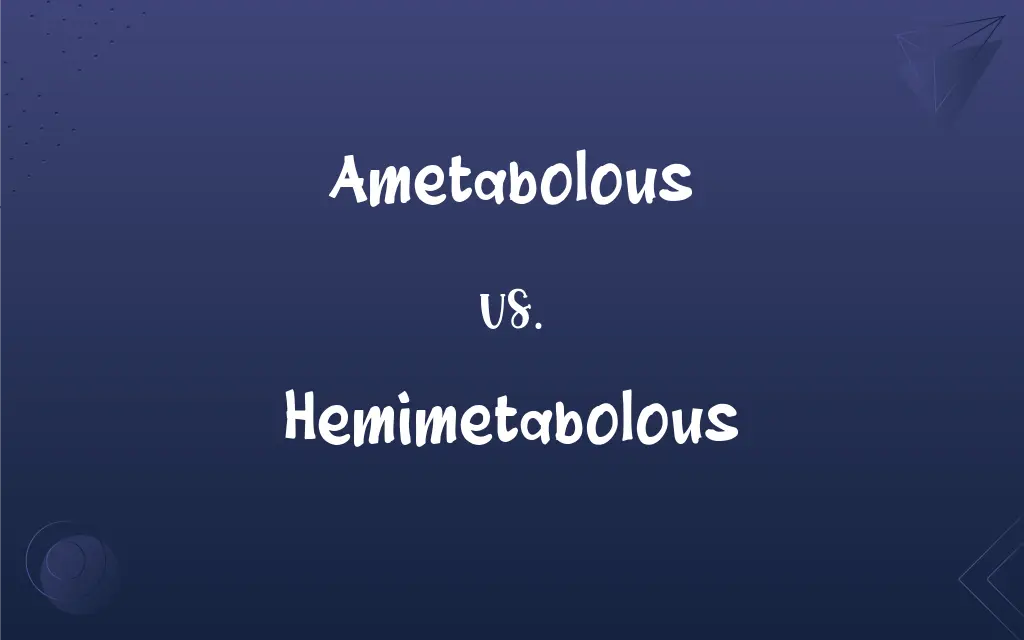Ametabolous vs. Hemimetabolous: What's the Difference?
Edited by Aimie Carlson || By Harlon Moss || Published on February 25, 2024
Ametabolous insects show no metamorphosis and resemble adults from hatching, whereas hemimetabolous insects undergo partial metamorphosis with distinct nymph stages.

Key Differences
Ametabolous insects are characterized by their lack of metamorphosis. Once they hatch from eggs, they already resemble miniature adults. This contrasts with hemimetabolous insects, which go through a partial metamorphosis involving a nymph stage that gradually matures into an adult form.
In ametabolous development, insects do not undergo significant changes in body form as they grow. They simply molt, increasing in size. Hemimetabolous insects, on the other hand, show distinct changes during their nymph stages, gradually developing adult features like wings and reproductive structures.
Examples of ametabolous insects include silverfish and bristletails. These insects maintain a consistent body form throughout their life. Hemimetabolous insects, such as grasshoppers and cockroaches, develop through several nymph stages, each slightly more resembling the adult form.
The reproductive strategies also differ. Ametabolous insects are ready to reproduce soon after their final molt. In contrast, hemimetabolous insects only achieve reproductive maturity after completing their nymph stages and reaching the adult form.
In terms of ecological adaptation, ametabolous insects are often found in stable environments as their consistent form throughout life suits a specific niche. Hemimetabolous insects, with their changing forms, can adapt to varying ecological niches during their life stages.
ADVERTISEMENT
Comparison Chart
Metamorphosis
No metamorphosis
Partial metamorphosis
Developmental Stages
Egg, nymph (adult-like)
Egg, nymph, adult
Body Form Changes
No significant changes
Gradual changes to adult form
Examples
Silverfish, bristletails
Grasshoppers, cockroaches
Reproductive Maturity
Soon after final molt
After reaching adult form
ADVERTISEMENT
Ametabolous and Hemimetabolous Definitions
Ametabolous
Lifecycle lacking distinct larval or pupal stages.
In ametabolous development, there are no larval stages like in butterflies.
Hemimetabolous
Development with partial metamorphosis through nymph stages.
Hemimetabolous insects like grasshoppers go through several nymph stages.
Ametabolous
Development with no metamorphosis from juvenile to adult.
Silverfish are ametabolous, maintaining their form throughout their lives.
Hemimetabolous
Lifecycle includes egg, multiple nymph stages, and adult.
In hemimetabolous development, nymphs gradually transform into adults.
Ametabolous
Insects that resemble adults from hatching.
Ametabolous insects like bristletails don't change much as they grow.
Hemimetabolous
Gradual appearance of adult features during growth.
Hemimetabolous insects develop adult features like wings over time.
Ametabolous
Growth through molting without significant body change.
Ametabolous species molt to grow but keep the same appearance.
Hemimetabolous
Reproductive maturity only after reaching the adult stage.
Hemimetabolous insects can reproduce only after they become adults.
Ametabolous
Reproduction occurs soon after the final molt.
Ametabolous insects are ready to reproduce almost immediately after their last molt.
Hemimetabolous
Nymphs resemble adults but lack wings and reproductive organs.
The nymphs of hemimetabolous species are wingless and can't reproduce.
Ametabolous
Alternative form of ametabolic
Hemimetabolous
See incomplete metamorphosis.
Ametabolous
Undergoing slight or no metamorphosis
Hemimetabolous
Exhibiting hemimetabolism.
Hemimetabolous
(of an insect with aquatic young) undergoing incomplete metamorphosis in which the young does not resemble the adult
FAQs
Can hemimetabolous nymphs reproduce?
No, they can reproduce only as adults.
Are ametabolous insects common?
They are less common than other types.
What's a common hemimetabolous insect?
Grasshoppers are well-known hemimetabolous insects.
What does ametabolous mean?
It refers to insects that don't undergo metamorphosis.
Are hemimetabolous insects born with wings?
No, they develop wings during nymph stages.
Do ametabolous insects grow wings?
No, they don't develop wings at any stage.
What's unique about hemimetabolous nymphs?
They resemble adults but lack complete adult features.
How do ametabolous insects adapt to their environment?
They often inhabit stable environments suited to their unchanging form.
Can ametabolous insects fly?
No, they lack wings in all life stages.
What is hemimetabolous development?
It's partial metamorphosis with distinct nymph stages.
Do hemimetabolous insects change significantly?
Yes, especially during their transition to adulthood.
Do hemimetabolous insects live in varied habitats?
Yes, their changing forms allow adaptation to different habitats.
How do ametabolous insects reproduce?
They reproduce soon after reaching their adult-like form.
When do hemimetabolous insects reach sexual maturity?
Only after they complete their nymph stages.
Is the ametabolous lifecycle simpler than hemimetabolous?
Yes, due to the absence of distinct life stages.
What's an example of an ametabolous insect?
Silverfish are a classic example.
How do ametabolous insects molt?
They molt to grow but retain the same basic body form.
How do hemimetabolous insects differ from holometabolous?
Hemimetabolous insects don't have a pupal stage like holometabolous insects.
Do ametabolous insects undergo drastic changes?
No, they have minimal physical changes.
What are the stages of hemimetabolous development?
Egg, nymph, and adult stages.
About Author
Written by
Harlon MossHarlon is a seasoned quality moderator and accomplished content writer for Difference Wiki. An alumnus of the prestigious University of California, he earned his degree in Computer Science. Leveraging his academic background, Harlon brings a meticulous and informed perspective to his work, ensuring content accuracy and excellence.
Edited by
Aimie CarlsonAimie Carlson, holding a master's degree in English literature, is a fervent English language enthusiast. She lends her writing talents to Difference Wiki, a prominent website that specializes in comparisons, offering readers insightful analyses that both captivate and inform.































































